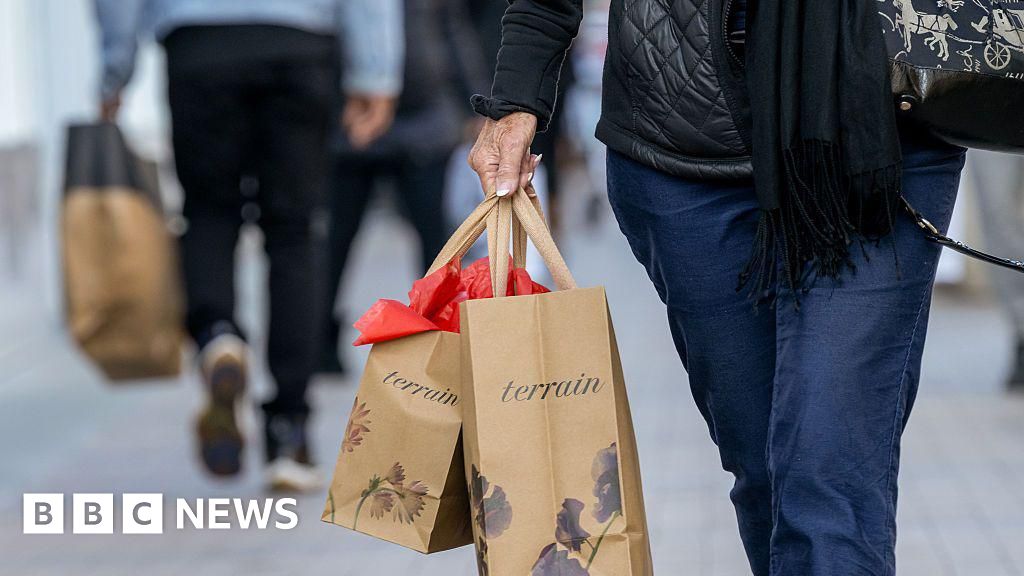Business
Health care inflation rises as patients, employers brace for biggest jump in health spending in 15 years

Jose Luis Pelaez Inc | Digitalvision | Getty Images
Health-care inflation is fueling higher coverage costs, setting the stage for what could be the largest increase in health-care spending by large employers in 15 years.
Medical care costs in August rose 4.2% on an annualized basis, according to the Labor Department’s Consumer Price Index, compared to an overall inflation rate of 2.9%. The cost of doctors’ visits climbed 3.5%, while hospital and outpatient services jumped 5.3%.
Those price increases are contributing to higher health insurance costs for 2026. Consumers who don’t qualify for government subsidies to buy health coverage on the Affordable Care Act exchanges could face double-digit premium increases for next year, according to early filings from insurers.
Workers with employer health coverage could also have to pay higher premium and out-of-pocket costs next year.
Large employers are projecting their overall health coverage costs will rise an average of 9% in 2026, according to several business group surveys, which would be the highest level of health-care inflation since 2010.
More than half of companies surveyed by benefits consulting firm Mercer earlier this year said they are considering passing on some of those increases to workers, but the Business Group on Health says most large employers in its survey are looking for other ways to cut costs.
“Employers have shied away in every way possible, from passing on costs to employees. This year, we see the first indication that they may look to pass some of that on to employees, but again, only as a last resort. They’re going to try and pull as many other levers as possible,” said Ellen Kelsay, BGH president and CEO.
Employer cost drivers: cancer drugs and GLP-1s
Shana Novak | Stone | Getty Images
Prescription drug prices rose 0.9% in August, according to the Consumer Price Index, which considers a range of widely-used generic and brand-name drugs.
But for large employers, expensive drugs are the major drivers of higher health spending.
Companies surveyed by BGH are projecting a 12% increase in pharmaceutical costs next year, on top of an 11% hike this year fueled by cancer drugs and diabetes and obesity treatments like Novo Nordisk’s Wegovy and Ely Lilly’s Zepbound.
“Cancers have been for the fourth year in a row, the top condition driving healthcare costs — cancers at younger ages, later stage diagnoses,” said Kelsay, who added that pricy weight loss drugs are are a close second.
“When it comes to the treatment of obesity, that has been the space that has been the most frothy for the past two to three years and has been what has fueled a lot of this pharmaceutical spending,” she said.
Nearly two-thirds of employers with 20,000 workers or more offer access to weight loss drugs known as GLP-1s, according to Mercer. Less than half of small employers surveyed plan to offer access in 2026.
With growing demand for the drugs, more companies are tightening eligibility requirements and beginning to explore more affordable ways to provide access for their employees, including the cash-pay market.
Cash-pay GLP-1s
A telehealth executive whose firm offers compounded GLP-1s told CNBC that some large employers are quietly letting workers know they can use health savings accounts to buy the medications for less in the cash market.
“They are worried about how much [the drugs] cost, but that doesn’t mean they don’t think their employees shouldn’t have access to them. They just don’t want to have to pay for it,” said the executive, who spoke on condition of anonymity because of the confidential nature of the discussions.
Health account data shows more workers are turning to direct-to-consumer options, including Eli Lilly’s Lilly Direct and Novo Nordisk’s Novocare online pharmacies, both of which offer their weight loss drugs at roughly half the list prices of more than $1000.
GLP-1 purchases are now the top category of cash-pay spending in pre-tax flexible spending and health savings accounts, for expenses not covered by insurance, according to the CEO of health payments processor Paytient.
“We see a tripling from last year to this year of usage at GLP-1 oriented providers. These are places like Lilly Direct, like Ro, like Hims & Hers, and that’s a growing segment,” said Paytient founder and CEO Brian Whorley.
But employers worry that the cash-pay trend leaves lower-income workers out of the equation because they can’t afford the out-of-pocket costs. That is prompting discussions about how their companies can obtain cash-pay prices to help boost more equitable access for employees.
Self-insured employers have contracted directly with so-called Centers of Excellence for specialty medical care such as cancer treatment and joint replacements. But they can’t currently do the same for many drugs. Under agreements with pharmacy benefit management firms, or PBMs, both the drugmakers and employers would violate their contracts by using a direct cash-pay process.
But employers are increasingly pressing PBMs for better options, says BGH’s Kelsay. They are beginning to consider new types of benefit managers, which are proposing new payment models for drugs in the development pipeline.
“There are some new entities — some startups in this space — that are building out products and solutions where they are going on behalf of a pooled group of employers to negotiate with manufacturers on certain cell and gene therapies,” she said.
Paytient’s Whorley calls the challenge of making GLP-1s more affordable a stress test moment for employers and PBMs.
“They’re at a perfect sort of Venn Diagram of clinically effective drugs that change people’s lives, that increasingly will force a choice,” when it comes to financing, Whorley said. “If we get this right, it can provide a blueprint for all the drugs like GLP-1s that will … present challenges for health plans.”
Business
Tariff jitters: US consumer confidence slips in December; inflation and jobs worries deepen – The Times of India

US consumer confidence weakened in December, sliding to its lowest level since President Donald Trump rolled out sweeping tariffs earlier this year, as households grew more anxious about high prices, trade levies and job prospects, according to a survey by the Conference Board.The Conference Board said its consumer confidence index fell 3.8 points to 89.1 in December from an upwardly revised 92.9 in November, AP reported. The reading is close to the 85.7 level recorded in April, when the Trump administration introduced import taxes on key US trading partners, AP reported.Consumers’ assessment of current economic conditions saw a sharper drop. The present situation index fell 9.5 points to 116.8, reflecting growing unease about inflation and employment conditions. Write-in responses to the survey showed that prices and inflation remained the biggest concern for consumers, alongside tariffs.Short-term expectations for income, business conditions and the labour market were little changed at 70.7, but remained well below 80 — a threshold that can signal a recession ahead. This was the 11th straight month that expectations stayed under that level.Perceptions of the job market also weakened. The share of consumers who said jobs were “plentiful” fell to 26.7% in December from 28.2% in November, while those who said jobs were “hard to get” rose to 20.8% from 20.1%.The softer sentiment follows recent labour market data showing mixed signals. Government figures released last week showed the US economy added 64,000 jobs in November after losing 105,000 jobs in October. The unemployment rate climbed to 4.6% last month, its highest level since 2021.Economists say the labour market is stuck in a “low hire, low fire” phase, as companies remain cautious amid uncertainty over tariffs and the lingering effects of high interest rates. Since March, average monthly job creation has slowed to about 35,000, down from 71,000 in the year ended March. Federal Reserve chair Jerome Powell has said he suspects those figures could be revised even lower, AP reported.
Business
US economy grows at fastest pace in two years

The US economy picked up speed over the three months to September, as consumer spending jumped and exports increased.
The world’s largest economy expanded at an annual rate of 4.3%, up from 3.8% in the previous quarter. That was better than expected, and marked the strongest growth in two years.
The figures offer a clearer picture of the state of the US economy heading into the end of the year, after data collection had been delayed by the US government shutdown.
The report showed consumer spending rising by 3.5%, compared with 2.5% in the previous quarter.
Business
Fish and chip shop offers 100 free Christmas meals in Southampton

“It’s just a way of us giving back to the community,” says a fish and chip shop owner, who is giving away 100 free meals on Christmas Eve.
Raj Khaira, from Southampton, has owned Top Catch fish and chips in Shirley for five years and says he wants to support lonely people in the area.
He says he feels lucky to have a big family but knows for some customers a conversation with a shopkeeper might be the only one they have some days.
He says the shop will give portions of sausage and chips to those in need as a way of “giving back to the people who haven’t got family around them and sometimes can’t afford a hot meal”.
Mr Khaira speaks about working in business all of his life and how much he enjoys meeting “different people every day, from different backgrounds”.
“I’ve done it since I was a young kid so it’s all I really know,” he says.
He adds that many of his customers are elderly and do not have connections over the festive period.
“Christmas for majority of us is probably going to be a joyful and busy day but for some people it’s probably going to be a quiet day,” he says.
After posting about the plans to donate on social media he received a lot of publicity and Mr Khaira is prepared to “probably do more than” 100 meals.
He says the shop has already organised a toy and present drop off to Southampton hospitals this December, with many of the donations coming from customers.
He says: “We’re only where we are as a busy shop because of our community and our lovely customers that come in and sometimes you’ve got to give back and I’m happy to do that.”
Looking back on some of the negative news reported in Shirley earlier this year with the rise in anti-social behaviour in the area, he admits he had suffered.
His shop window was smashed in the summer, but he says: “Christmas time lets us just try and forget that for a minute and just try and have a good time, and reflect back on the year and hopefully next year is going to be a better one.”
-

 Business1 week ago
Business1 week agoStudying Abroad Is Costly, But Not Impossible: Experts On Smarter Financial Planning
-

 Fashion5 days ago
Fashion5 days agoIndonesia’s thrift surge fuels waste and textile industry woes
-

 Business1 week ago
Business1 week agoKSE-100 index gains 876 points amid cut in policy rate | The Express Tribune
-

 Sports1 week ago
Sports1 week agoJets defensive lineman rips NFL officials after ejection vs Jaguars
-

 Business5 days ago
Business5 days agoBP names new boss as current CEO leaves after less than two years
-

 Tech5 days ago
Tech5 days agoT-Mobile Business Internet and Phone Deals
-

 Entertainment1 week ago
Entertainment1 week agoPrince Harry, Meghan Markle’s 2025 Christmas card: A shift in strategy
-

 Sports5 days ago
Sports5 days agoPKF summons meeting after Pakistani player represents India in kabaddi tournament









